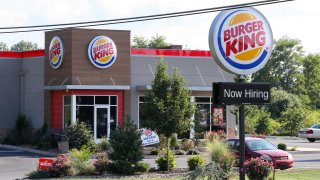
- Restaurant Brands International on Tuesday reported quarterly earnings and revenue that topped analysts' expectations.
- The company said global digital sales climbed from $6 billion in 2020 to $10 billion in 2021, accounting for 30% of its system-wide sales.
- Popeyes reported same-store sales declines, while Burger King and Tim Hortons both reported strong same-store sales growth.
Restaurant Brands International on Tuesday reported quarterly earnings and revenue that topped analysts' expectations as digital orders made up nearly a third of the company's global sales.
Shares of the company rose more than 4% in morning trading.
Here's what the company reported for the quarter ended Dec. 31 compared with what Wall Street was expecting, based on a survey of analysts by Refinitiv:
Get Southern California news, weather forecasts and entertainment stories to your inbox. Sign up for NBC LA newsletters.
- Earnings per share: 74 cents adjusted vs. 70 cents expected
- Revenue: $1.55 billion vs. $1.5 billion expected
The restaurant company reported fourth-quarter net income of $261 million, or 57 cents per share, up from $138 million, or 30 cents per share, a year earlier.
Excluding items, Restaurant Brands earned 74 cents per share, beating the 70 cents per share expected by analysts surveyed by Refinitiv.
Money Report
Net sales rose 14% to $1.55 billion, topping expectations of $1.5 billion. Higher prices across its brands helped boost sales, and the company plans to keep hiking prices in 2022 to fight inflation.
The company said global digital sales climbed from $6 billion in 2020 to $10 billion in 2021, accounting for 30% of its system-wide sales. Its strong digital growth came as some of the company's restaurants faced labor challenges, leading to reduced operating hours and shuttered dining rooms. More than half of sales in international markets came from digital orders in the fourth quarter, while home markets for Tims, Burger King and Popeyes were further behind.
Tim Hortons reported same-store sales growth of 10.3% in the quarter, falling shy of StreetAccount's 10.6% estimate. The Canadian coffee chain has taken longer than Restaurant Brands' other chains to bounce back from the pandemic because of its home market's restrictions. And even before the health crisis, the chain was investing in new coffee-making equipment and revamping its menu to encourage Canadians to return to its stores.
A collaboration with Canadian singer Justin Bieber helped fuel Tims' same-store sales growth in the quarter. The partnership included three flavors of Timbits, renamed Timbiebs for the collaboration. Executives said it was one of the top-performing promotions in recent memory.
"I'm a Belieber, and you can expect to see more from this exciting partnership in the years ahead," Restaurant Brands CEO Jose Cil said on the company's earnings call.
As the Canadian market matures, Tims has been expanding internationally. It opened its 400th location in China in January, less than three years after it opened its first restaurant there. The chain plans to add to its U.S. footprint, anticipating that it will open its first location in Houston this summer. New U.S. stores have smaller footprints and a more concentrated menu.
Burger King's same-store sales climbed 11.3%, topping StreetAccount's estimates of 10%. But U.S. same-store sales growth was just 1.8%. The burger chain has been struggling in its home market, outpaced by rivals like McDonald's.
The chain completed a first wave of menu cuts in late December to speed up drive-thru times. So far, it hasn't had any impact on Burger King's same-store sales, executives said. Burger King has also been eliminating paper coupons in favor of mobile app deals and its loyalty program rewards.
Tom Curtis, president of Burger King U.S. and Canada, said the chain is reviewing its creative and media accounts. Restaurant Brands plans to present a broader plan for Burger King's U.S. business later this year.
Popeyes Louisiana Kitchen was the only chain to report same-store sales declines. The fried chicken chain's same-store sales shrank 0.4% globally and 1.8% in the U.S. A year earlier, its global same-store sales fell 5.8%. The popularity of its chicken sandwich helped the chain's sales soar in 2019 and early 2020, but sales may finally be stabilizing. Wall Street was predicting same-store sales growth of 2.2% for the chain, according to StreetAccount estimates.
"Ongoing labor challenges led to reduced operating hours and service modes, impacting comparable sales by roughly 1%," Cil said. "In addition, chicken sandwich volumes remain pressured by competitors, which as you may recall, started making their sandwich debuts in early 2021."
Firehouse Subs, the newest addition to Restaurant Brands' portfolio, saw its same-store sales climb 14.7% in the quarter. Restaurant Brands bought the sandwich chain in mid December for $1 billion, so its performance was only included in financial results from Dec. 15 to Dec. 26.






